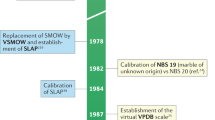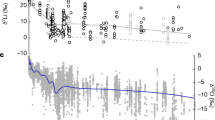Abstract
The recent breakthrough in our ability to detect the radioactive isotope 36Cl (half-life T½ = 301,000 yr) at natural levels by accelerator mass spectrometry1 allows the processes of salination of water systems to be studied in a new way by distinguishing the chloride content originating in young rainwaters and their subsequent evaporation from that generated by the leaching of ancient rocks. Results for the Jordan River/Dead Sea system show that the amount of chloride leached from rocks ranges from ∼70% in source springs to >90% in water bodies downstream. Furthermore, the amount of water left after evaporation decreases from ∼50% in the source springs to 20% in the intermediate Lake Kinneret. In the terminal Dead Sea, 99% of the stable chloride originates from ancient rocks and evaporite formations while ∼80% of its 36Cl content is of meteoric origin. Using 36Cl measurements, we estimate the accumulation time of the Dead Sea salt to be 19,000–25,000 yr.
This is a preview of subscription content, access via your institution
Access options
Subscribe to this journal
Receive 51 print issues and online access
$199.00 per year
only $3.90 per issue
Buy this article
- Purchase on Springer Link
- Instant access to full article PDF
Prices may be subject to local taxes which are calculated during checkout
Similar content being viewed by others
References
Elmore, D. et al. Nature 277, 22–25 (1979).
Bonner, F. T. et al. Geochim. cosmochim. Acta 25, 261–266 (1961).
Simpson, B. & Carmi, I. J. Hydrol. 62, 225–242 (1983).
Vogel, J. C. & Waterbolk, H. T. Radiocarbon 14, 6–110 (1972).
Fink, D. et al. Nucl. Instrum. Meth. B5, 123–128 (1984).
Bentley, H. W., Phillips, F. M. & Davis, S. N. in Handbook of Environmental Isotope Geochemistry, Vol. 2 (eds Fritz, P. & Fontes, J. C.) (Elsevier, Amsterdam, in the press).
Dalin, Y. Proc. Symp. Hydrological Activities Dictated by the Energy Crisis, 5 (Israel National Council for Research and Development, Rehovot, Israel, 1981) (in Hebrew).
Elmore, D. et al. Nature 300, 735–737 (1982).
Mazor, E., Mero, F. J. Hydrol. 7, 318–333 (1969).
Bentor, Y. K. Geochim. cosmochim. Acta 25, 239–260 (1961).
Author information
Authors and Affiliations
Rights and permissions
About this article
Cite this article
Paul, M., Kaufman, A., Magaritz, M. et al. A new 36Cl hydrological model and 36Cl systematics in the Jordan River/Dead Sea system. Nature 321, 511–515 (1986). https://doi.org/10.1038/321511a0
Received:
Accepted:
Issue Date:
DOI: https://doi.org/10.1038/321511a0
Comments
By submitting a comment you agree to abide by our Terms and Community Guidelines. If you find something abusive or that does not comply with our terms or guidelines please flag it as inappropriate.



